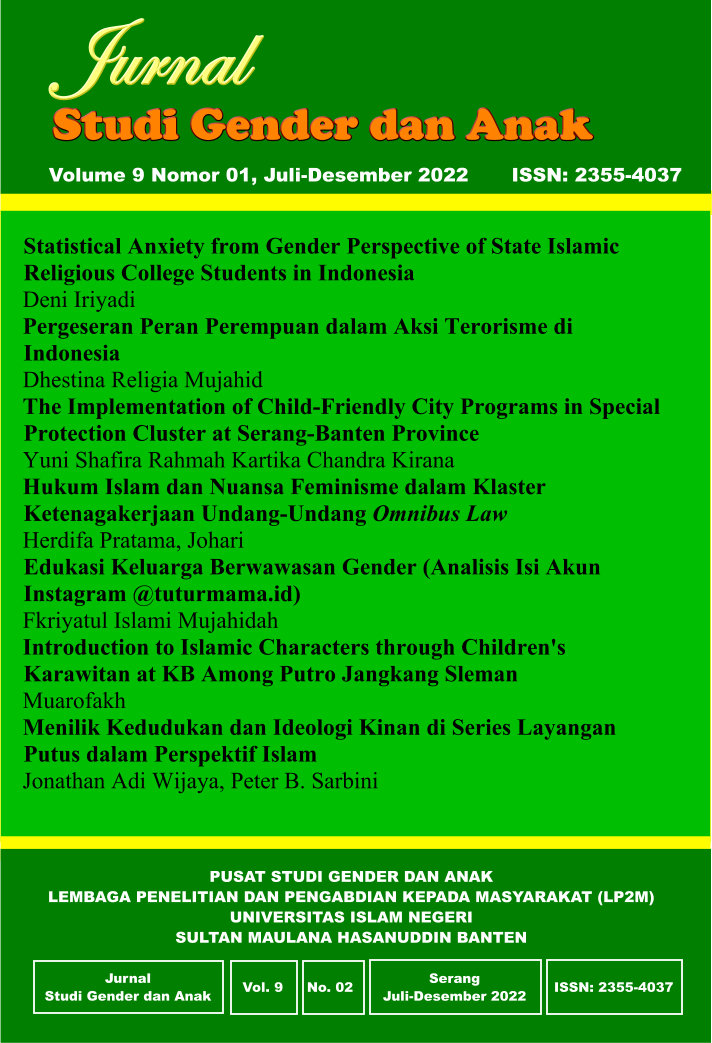Menilik Kedudukan dan Ideologi Kinan di Series Layangan Putus dalam Perspektif Islam
DOI:
https://doi.org/10.32678/jsga.v9i02.6946Keywords:
Social Phenomenon, John Fiske, Layangan Putus, Kinan SakinahAbstract
This article focuses on the web series Layangan Putus that is broadcast on one of the online video channels. The author tries to see the position of the wife in the character Kinan who became the main character in the web series Layangan Putus. By raising the theme of household and the presence of a third person in the household, the web series Layangan Putus became popular in the community. Kinan, who betrayed by Aris with his manipulative demeanor, becomes a central figure who fighting for herself and her family. With regard to research’s aim, this article proposed issues: (1) Does Kinan display the figure of a wife who is filial to the husband in accordance with the Islamic perspective? (2) What is the ideology displayed from this broken Kite web series? This article uses John Fiske's semiotics methods with literature studies and interviews with people around the author who understand the problems in this article. The results showed that Kinan was a loyal wife and devoted to her husband. Kinan is very much trying for a marriage that is sakinah, mawadah, and warohmah. Despite conflicts within her family, Kinan never exposed the matter to others, including his mother. This Kite Break up web series shows the existence of feminism and patriarchal ideologies in storylines and characterization
Downloads
References
Agus, B. (2021, November 28). Makna Layangan Putus Dimata Penulis, Serial Drama yang Tayang di WeTV. Diambil 13 Februari 2022, dari Baktos website: https://www.baktos.com/infotainment/makna-layangan-putus-dimata-penulis-serial-drama-yang-tayang-di-wetv/
Ardhian, R. F., Anugrah, S., & Bima, S. (2016). Poligami dalam Hukum Islam dan Hukum Positif Indonesia Serta Urgensi Pemberian Izin Poligam di Pengadilan Agama. Privat Law, 3(2), 100–107.
Asmiraty, A. (2020). Problematika Rumah Tangga Dalam Perspektif Pendidikan Islam. AL-WARDAH: Jurnal Kajian Perempuan, Gender Dan Agama, 14(1), 11–27. https://doi.org/10.46339/al-wardah.v14i1.242
Batoebara, M. U. (2022). Efek Nonton Film “Layangan Putus” Istri Posesif. Network Media, 5(1), 78–87. https://doi.org/10.46576/jnm.v5i1.1830
Direktorat Bina KUA dan Keluarga Sakinah. (2018). Kompilasi Hukum Islam di Indonesia. Jakarta: Direktorat Jenderal Bimbingan Masyarakat Islam.
Erlangga, M. (2014, Juni 6). Tren Web Series Indonesia Semakin Kreatif. Diambil 28 Februari 2022, dari https://dailysocial.id/post/tren-web-series-indonesia-semakin-kreatif
Halik, A. (2012). Tradisi Semiotika Dalam Teori dan Penelitian Komunikasi. Makassar: Alauddin Press.
Hikmah, S. (2012). FAKTA POLIGAMI SEBAGAI BENTUK KEKERASAN TERHADAP PEREMPUAN. Sawwa: Jurnal Studi Gender, 7(2), 1. https://doi.org/10.21580/sa.v7i2.646
Hudafi, H. (2020). Pembentukan Keluarga Sakinah Mawaddah Warahmah menurut Undang – Undang Nomor 1 Tahun 1974 dan Kompilasi Hukum Islam. Al Hurriyah : Jurnal Hukum Islam, 5(2), 172. https://doi.org/10.30983/alhurriyah.v5i2.3647
Magdalena, R. (2017). KEDUDUKAN PEREMPUAN DALAM PERJALANAN SEJARAH (Studi Tentang Kedudukan Perempuan dalam Masyarakat Islam). Harakat An-Nisa: Jurnal Studi Gender Dan Anak, 2(1). Diambil dari http://e-journal.lp2m.uinjambi.ac.id/ojp/index.php/an-Nisa/article/view/116
Mahsun, A. A. (2022, Maret 25). Hasil Wawancara Mengenai Gender dan Poligami dalam Pernikahan Islam.
Muhajarah, K. (2017). PERSELINGKUHAN SUAMI TERHADAP ISTRI DAN UPAYA PENANGANANNYA. Sawwa: Jurnal Studi Gender, 12(1), 23–40. https://doi.org/10.21580/sa.v12i1.1466
Mutaqy, R. M., Sarmini, M., Sukartiningsih, S., Rahmayanti, R., & Kurnia, B. (2018). Rural Women Cheating Strategy. Proceedings of the 1st International Conference on Social Sciences (ICSS 2018). Dipresentasikan pada Proceedings of the 1st International Conference on Social Sciences (ICSS 2018), Bali, Indonesia. Bali, Indonesia: Atlantis Press. https://doi.org/10.2991/icss-18.2018.315
Prasetio, V., Ristiawati, T., & Rismolita, C. E. E. (2021). PEMICU PERSELINGKUHAN ISTRI ANALISIS TOKOH SUGIRI TOKO PADA FILM RED (2020). KOMPETENSI, 1(09), 786–794.
Ratnasari, D., Cangara, H., & Hasyim, M. (2015). PERSELINGKUHAN DAN KESETIAAN DALAM SINETRON “CATATAN HATI SEORANG ISTRI” (SUATU STUDI ANALISIS KOMUNIKASI KELUARGA DALAM PERSPEKTIF SEMIOTIKA). KAREBA : Jurnal Ilmu Komunikasi, 270–286. https://doi.org/10.31947/kjik.v4i3.626
Sari, M., & Fahrudin, F. (2021). Konsep Keharmonisan Rumah Tangga Dalam Al-Qur’an (Interpretasi Ma’na-Cum-Maghza atas Term Libas dalam QS. Al-Baqarah: 187). Al-Dzikra: Jurnal Studi Ilmu al-Qur’an dan al-Hadits, 15(2), 195–208. https://doi.org/10.24042/al-dzikra.v15i2.7009
Sobur, A. (2001). Analisis Teks Media. PT Remaja Rosdakarya.
Suhendra, D. (2016). Khulu’ dalam Persfektif Hukum Islam. ASY SYAR’IYYAH: JURNAL ILMU SYARI’AH DAN PERBANKAN ISLAM, 1(1), 219–233. https://doi.org/10.32923/asy.v1i1.672
Uddin, A. M. (2021). Fenomena Dampak Negatif Media Sosial Terhadap Keharmonisan Rumah Tangga: Legitima : Jurnal Hukum Keluarga Islam, 3(2), 126–146. https://doi.org/10.33367/legitima.v3i2.1538
Vera, N. (2014). Semiotika dalam Riset Komunikasi. Bogor: Ghalia Indonesia.
Wahyu, E. R., Jazari, I., & Kurniawati, D. A. (2020). ISTRI KARIER DALAM MEWUJUDKAN KELUARGA SAKINAH. Jurnal Hikmatina, 2(3), 67–75.
Wholu, C. (2022, Februari 12). Hasil Wawancara mengenai Wanita dalam Pernikahan Islam [Google Meet]. Diambil dari https://meet.google.com/epy-ribt-ggw
Wijaya, J. A., & Firmanto, A. D. (2021). REPRESENTASI GENDER PADA FILM TILIK MENURUT STUDI SEMIOTIK ROLAND BARTHES. Interaksi: Jurnal Ilmu Komunikasi, 10(2), 166–176. https://doi.org/10.14710/interaksi.10.2.166-176
Downloads
Published
Versions
- 2023-02-23 (2)
- 2022-12-25 (1)
Issue
Section
License
Copyright (c) 2022 Jonathan Adi Wijaya, Peter Bruno Sarbini

This work is licensed under a Creative Commons Attribution-ShareAlike 4.0 International License.




